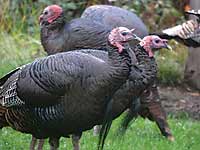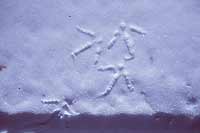Talkin’ Turkey |
|
November has turkey written all over it.
 Yet it’s a challenge to think that between the Pilgrims and the pioneers on the Oregon Trail, the native wild turkey populations were just about extirpated across North America. Abundant from coast to coast, these birds declined due to overhunting and loss of habitat as settlers expanded their range. By the end of the 20th century, the bird once considered to be our nation’s symbol, existed in pockets and small populations. Amazing to a species that lost out to the bald eagle as a national symbol by one vote. Prior to the Pilgrims, Native Americans hunted and trapped these cagey birds. They even domesticated them in the Southwest, the birds free-roaming on kiva roofs or across middens in Ancestral Puebloans’ cliff dwellings. The natives used the turkey feathers in prayer sticks and made feather blankets, as well. Turkey Pen Ruin in southern Utah has an enclosure that archaeologists believe once housed these birds like backyard chickens today. Through the efforts by state agencies and private conservation organizations like the Turkey Federation, wild turkeys had returned to much of their native habitat in North America. It’s not uncommon to see a flock of birds foraging for seeds along Indian Creek or roosting in massive cottonwoods along the Colorado River near Dewey Bridge.  Though many of these reintroduced birds have different genetics to their wild cousins, it’s still cool to see these birds strutting through the canyons and up into the forests in Utah. Turkey habitat is pretty diverse from open oak woodlands up into the mountains. They birds prefer habitat with “mast-producing” fruit such as acorns. Find groves with Gambel’s oak and the turkeys may not be far away. Though many of these reintroduced birds have different genetics to their wild cousins, it’s still cool to see these birds strutting through the canyons and up into the forests in Utah. Turkey habitat is pretty diverse from open oak woodlands up into the mountains. They birds prefer habitat with “mast-producing” fruit such as acorns. Find groves with Gambel’s oak and the turkeys may not be far away. Of the two subspecies that occur in the region, the Merriam’s turkey is more the mountain dweller, leaving the lower PJ (pinyon-juniper woodlands) or cottonwood bottoms to its cousin the Rio Grande turkey. Telling them apart is tough; you’ve got to see the white tail feather tips of the Merriam’s’ versus the buff or tan tips on the Rio Granders. Field marks that only birders and turkey hunters can love.  In modern history, November used to be a good month for the wild toms, jakes and jennies. The hunting season for turkey was only open in the spring, but after a 30-year hiatus, hunters can try to bag these cagey birds in November. If you think hunting turkeys is easy as pecan pie, think again. These birds are wary, can disappear into a thicket without ruffling a feather and know how to use stealth to their advantage. You also might think their large size makes them easy to see hunkered down in the brush, but think again. In modern history, November used to be a good month for the wild toms, jakes and jennies. The hunting season for turkey was only open in the spring, but after a 30-year hiatus, hunters can try to bag these cagey birds in November. If you think hunting turkeys is easy as pecan pie, think again. These birds are wary, can disappear into a thicket without ruffling a feather and know how to use stealth to their advantage. You also might think their large size makes them easy to see hunkered down in the brush, but think again. You might have to be a coyote, bobcat or fox to sniff out these birds on the ground. Though the hens build a ground nest under dense cover, the young fall prey to these predators. As the birds mature and are able to fly, they find safety by roosting in trees, even large cottonwood trees that house a bald eagle’s nest. The eagles leave the turkeys alone. So this November, while you’re gathered with friends and family, give thanks to the wild cousins of those gracing your Thanksgiving dinner. For they represent the wild and wilderness. Now that’s something to talk turkey about.
|
|
